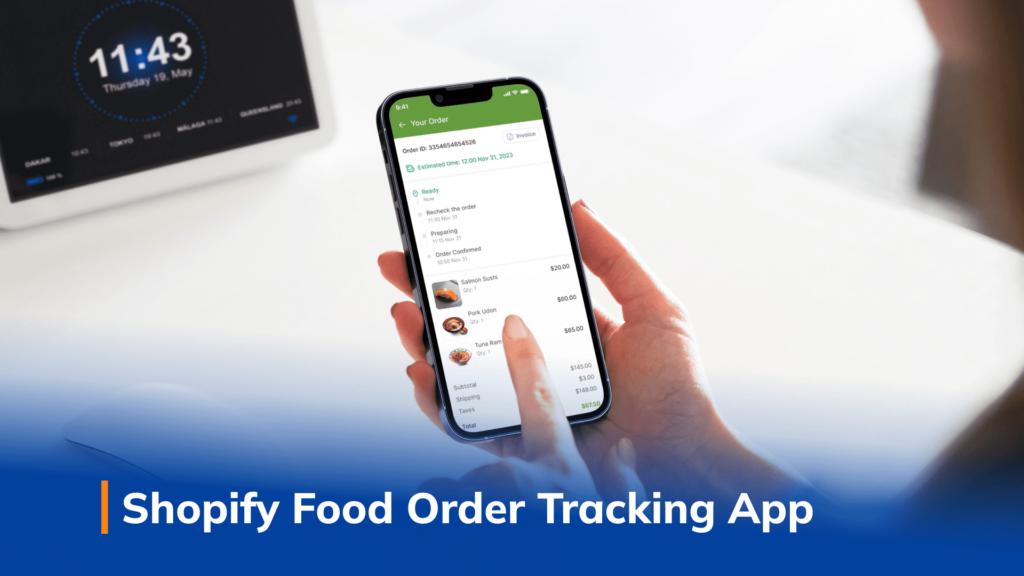Shopify Order Tracking App for The Food Industry
23/11/2023
1.97k
Table of Contents

TakeOut is a Shopify application that allows restaurants and food industry businesses to streamline their takeout service. Instead of relying on a third-party application to sell and deliver food online, customers can order directly from the restaurant with this Shopify order tracking app. Sounds like a delicious way to increase profit engagement with customers!
Almost everyone who lives in an urban area has had food delivered to them. Of course, there have always been a few more options when it comes to takeout. There’s the stereotypical “Chinese takeout” that comes in a paper oyster shell tossed into a bag with disposable chopsticks and a handful of fortune cookies. If only one of those fortune cookies had told us about the possibilities of future food delivery and takeout! Today, all of your favorite foods are available for takeout or delivery.
Shopify Serves Small Restaurant Businesses
The project began when a client approached us with the concept of giving small businesses a way to reduce their operating costs. Although there are many benefits to being listed on popular delivery and takeout websites and applications, but these benefits come at a financial cost. For some businesses, this is fine; just pay the fee and keep selling! However, some businesses prefer to keep these external costs to a minimum.
Utilizing Shopify’s Popularity in Japan
In Japan, Shopify has become increasingly popular. Our partner client saw an opportunity to capitalize on this popularity and create an application that gives restaurants a choice. Now, Japanese restaurants can choose to sell their products through a well-known service or put more effort into developing their own brand and selling their food directly to hungry end users.
TakeOut Functions for Foodies
The first function of TakeOut is the call function. This allows customers to place a takeout order from the restaurant’s Shopify website. The application shows where the food is in the pipeline, from the order being received, to being in the kitchen, to being ready for pickup. When the food is close to being ready, the application can send a push notification to notify the customer.
If a client restaurant wants to add additional customization to the pipeline or takeout application, we can accommodate any request. Again, this is the beauty of Shopify: with a qualified team, the customization possibilities are nearly endless!

User-friendliness is Delicious!
Furthermore, adding the TakeOut application to a restaurant’s Shopify is incredibly easy. In most cases, you won’t need a development team at all. We’ve created a step-by-step guide on how to integrate the app into an existing Shopify store. All the restaurant owner has to do is follow the steps, then they’re selling their deliciousness directly to customers. Similar to how customers might want to customize their food order, if there’s something that needs to be changed, we can do the customization for the restaurant’s Shopify.
TakeOut Challenges: Multiple Locations
The project itself was not too difficult. A small team developed the application over the course of three months. SupremeTech had a lot of experience working with Shopify and our partner Fracta on other projects.
We worked seamlessly with our client partner. Our Japanese business analyst coordinated communication between the engineering team and Japanese stakeholders. However, despite our best efforts, there was one particular challenge that nearly tripped us up! Development projects rarely go by without some challenge or miscommunication. However, during the TakeOut project, we were able to adapt and complete the project on time.
We worked under the assumption that the Shopify stores we were developing TakeOut for were stand-alone locations. We developed the app under without considering businesses with multiple locations. Due to Shopify’s policy, this required some last-minute tinkering. Fortunately, we were able to power through the last minute adjustments. Sudden changes are common in our industry. Nonetheless, we learned valuable lesson about adapting when the client’s specifications change.
Serving Customers With TakeOut
TakeOut was a Shopify eCommerce application that we developed to help small businesses. We continue to work closely with our partner client to add new features to the app as the market dictates. To date, TakeOut’s client restaurants and food lovers have praised its user-friendly interface. We’re excited to see how the platform continues to change the way we do eCommerce in the future.
Contact SupremeTech if you want the same Shopify order tracking app or any custom Shopify solutions. We make your business smarter and smoother!
Related Blog





















